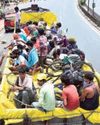NCRB data and other reports indicate how the most marginalised sections are also the most criminalised.

THE POLICE AND INVESTIGATION AGENCIES may deny bias in justice delivery, but prisons tell another story. Statistics released by the National Crime Records Bureau (NCRB) for 2015 show that Muslims constituted a greater share in the prison population than any other segment of people. While their share in India’s population as per Census 2011 was 14.2 per cent, their proportion in the undertrial prison population stood at 20.9 per cent. The percentage of convicted Muslims was 15.8 per cent. The percentage of Muslims among detainees was also high at 23.8 per cent. In fact, they fared as badly as Dalits and the tribal people. Together, these three communities constituted 39 per cent of the population but accounted for more than 55 per cent of all undertrials and 50.4 per cent of all convicts.
The Scheduled Castes (S.Cs) accounted for 16.6 per cent of the population but made up 21.6 per cent of all undertrials and 20.9 per cent of all convicts, whereas the Scheduled Tribes (S.Ts) accounted for 8.6 per cent of the population but made up 12.4 per cent of all undertrials and 13.7 per cent of all convicts.
This showed how the most marginalised people of the country were also the most criminalised. While tribal people and backward classes are easily branded as Maoists, Muslims automatically become terrorists and bear the social stigma throughout their lives even if they get acquitted.
The NCRB data also showed that in most States with a sizable number of Muslims, their percentage among undertrials and convicts was significantly higher than their share of the State population.
In Maharashtra, for instance, they accounted for only 11.5 per cent of the population but made up 30 per cent of all undertrials and 20 per cent of the convicts. In West Bengal, they formed 27 per cent of the population but made up almost half of all undertrials at 47 per cent and 40 per cent of the convicts.
This story is from the {{IssueName}} edition of {{MagazineName}}.
Start your 7-day Magzter GOLD free trial to access thousands of curated premium stories, and 9,000+ magazines and newspapers.
Already a subscriber ? Sign In
This story is from the {{IssueName}} edition of {{MagazineName}}.
Start your 7-day Magzter GOLD free trial to access thousands of curated premium stories, and 9,000+ magazines and newspapers.
Already a subscriber? Sign In

How Not To Handle An Epidemic
The lockdowns were meant to buy time to put in place appropriate health measures and contain the coronavirus’ spread, but they have failed to achieve the objective and heaped immense misery on the marginalised sections of society. India is still in the exponential phase of the COVID-19 infection and community transmission is a reality that the government refuses to accept.

Tragedy on foot
As the COVID-19-induced lockdown cuts the ground beneath their feet in Tamil Nadu, thousands of migrant workers are trudging along the highway to the relative safety of their upcountry homes.

Sarpanchs as game changers
Odisha manages to keep COVID-19 well under control because of the strong participation of panchayati raj institutions and the community at the grass-roots level under the leadership of Chief Minister Naveen Patnaik.

Scapegoating China
As the COVID-19 death rate spikes and the economy tanks in the United States, Donald Trump and his advisers target China and the World Health Organisation with an eye to winning the forthcoming presidential election.

New worries
Kerala’s measured approach to the pandemic and lockdown has yielded results. But it still has to grapple with their huge economic impact on its economy, which it feels the Centre’s special financial relief package does little to alleviate.
No love lost for labour
Taking advantage of the lockdown and the inability of workers to organise protests, many State governments introduce sweeping changes to labour laws to the detriment of workers on the pretext of reviving production and boosting the economy.

Capital's Malthusian moment
In a world that needs substantial reorienting of production and distribution, Indian capital is resorting to a militant form of moribund neoliberalism to overcome its current crisis. In this pursuit of profit, it is ready and willing to throw into mortal peril millions whom it adjudicates as not worth their means—an admixture of social Darwinism born of capital’s avarice and brutalism spawned by Hindutva. .

Understanding migration
When governments and their plans are found to be blatantly wanting in addressing reverse migration, exercises such as the Ekta Parishad’s survey of migrant workers throughout India can be useful to work out creative long-lasting solutions.

Waiting for Jabalpur moment
The Supreme Court’s role in ensuring executive accountability during the ongoing lockdown leaves much to be desired. Standing in shining contrast is the record of some High Courts.

An empty package
The Modi regime, which has been unable to control the COVID-19 infection, restore economic activity and provide relief to millions exposed to starvation, trains its sights on Indian democracy, making use of the panic generated by fear and a lockdown that forecloses paths of resistance.